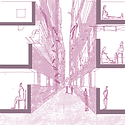
Folding Terrains
Epilogue
Epilogue
Cartography and ethnography are colonial tools to control urban conditions. These in turn got used to plan urban resources through enlightenment/modern principles of equity and efficiency. These principles have established the notion of standards and a constant generation of institutional infrastructure. However, spatial disciplines in cities have been historically shaped by capitalist modes of production which frame the city as a set of problems to be solved through order and infrastructure.
In this course, the initial identification of the space of disgust emerged from looking at the city through immediate reactions of erasure, denial or assuming the position of savior. Perceiving the city through body and senses led to the shift from framing the urban as a series of problems to be solved to a set of forces at play. This opened up different ways of engaging with the city in its fragments which do not necessarily sum up to become a whole but have rhythms of their own. The rhythms may reorganize, strengthen or dissolve in time.
An attempt of devising a softer approach of negotiating with the energies in the city was made. Being conscious of the approach not becoming a strategy of intervening enabled us to establish a physicality of space through the act of looking closely which indulges our bodily rhythms. Such an approach of engaging with the site helped us to redefine our agencies.
Market holds very dense crowd throughout the day. These density creates a tention, rush and discomfort.
Densely populated, High intensities of Vehicles, Traffic Congestion
People use this pocket space for drinking alcohol and smoking. And it intersect with sober individual.
The homeowner's friend regularly inspects the condition of the house from his window by observing activities and the state of objects inside.
Forces, Rhythms & Energies
The image of the poele moving in and out of these homes made of corrugated G.I sheets stood out. It unsettled me to think that people live in these home made primarily with corrugated sheets.
The skywalk's huge span and inaccessibility to various locations have made it dysfunctional.
Abandoned park and an isolated street, felt uncomfortable and unsafe to walk past
High congestion and disorder of traffic makes it unsafe for pedestrians.
Absence of plinth in the buildings leads to water logging which is not pleasant to walk through.
A collection of Engagements with the City and the Self
The accumulation of the garbage creates a sense of disgust while passing through the street.
In addition the fast pace movement of the adjacent WEH exhausted once sense of direction.
It is frequented by men who happen to inhabit the space (often not by choice) to fix the drain manually.
Huge flux of people constantly moving creating congestion
Highly restrictive because of the corporate and state infrastructure, people behave and think differently when they enter the site
The fish of the ‘machchi baazaar’ mixed with the rain and animals produce a smell which makes me uncomfortable.
The encroachment of the footpath as well as the road due to ‘over-spillage’ of the excesses of production became the point of disgust or dislike on this stretch of Eksar road
It is a dense site with a constant gaze and creates a fear of getting robbed.
Here, heaps of refuse splattered all over evoke an undeniable unease.
Introduction
There exist some spaces in the city, that one appreciates and some that evoke strong feelings of ‘disgust’ among others. This stems from a complex interplay of memory, context, and knowledge, both inherent and borrowed. Whilst one immerse themselves in the spaces they are fond of, they actively avoid the latter. It becomes important to recognize that these problems we perceive are not inherent characteristics of the city itself, but rather, a reflection of an individual’s personal beliefs, knowledge, and circumstances. Unlike fondness, the feeling of disgust elicits an alienating or exclusionary reaction.
In the midst of this duality, the phrase 'not in my backyard' takes on heightened significance, which triggers an apparent response to these urban perceptions that involves identifying these perceptions as problems that need resolution through a language of imposing order and control - an approach shaped historically by the colonial and modern hegemonies. With the challenge of unlearning these conventional methods of reading, understanding, and thus engaging with the city, the participants consciously spent time within their spaces of disgust, to experience them through their physical selves and senses.
Upon perceiving the site through the forces and rhythms existing in it, one must think of ways of engaging with them. Engagement, here, is consciously defined as distinct from mere reaction or intervention, representing a meaningful interaction with the city's rhythms and forces while refraining from the urge to identify and resolve perceived problems.

























.png)










